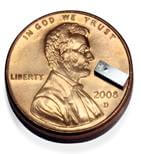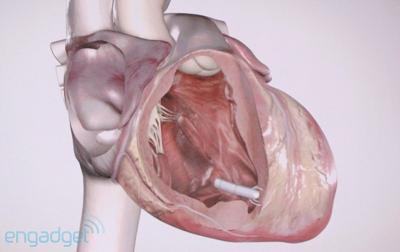
Look at the nail on your smallest finger. Chances are that it’s about twice as big as the pacemaker Medtronic is hoping to build in the next five years. The Minnesota based medical technologies giant is developing the world’s smallest pacemaker, small enough to fit directly on the heart. Not only will this allow the tiny device to work without electrical leads (wires) it will mean the device can be inserted via a catheter. No major surgery required. Still in the research phase, Medtronic has already created the majority of necessary components for the tiny pacemaker: circuit board, oscillator, capacitor, memory, and wireless telemetry so that the device can ‘speak’ to external monitoring devices. The only real thing missing is a power source. That hasn’t stopped Medtronic’s Vice President for Medicine and Technology, Stephen Oesterle, from showing off prototypes of the device at last year’s TEDMED conference and more recently to Technology Review’s Emily Singer. (Catch the amazing pics to the side and below.) If eventually successful, Medtronic’s miniaturization of the pacemaker will be a major accomplishment – helping lower the risks and improve the benefits of these kinds of devices. This is another great example of how implants are becoming better, smaller, and more common as medical technology continues to advance.
Singularity Hub usually doesn’t review devices that are still firmly entrenched in the research phase. Yet this proposed miniature pacemaker isn’t simply another idea on paper. This is the same company that currently dominates the pacemaker market, with each generation of their products becoming smaller, more resilient, and better suited to modern medicine. (For instance, they recently unveiled a pacemaker that is safe for use in MRI machines.) When Medtronic sends its VP out into public forums to announce the arrival of a minuscule new device set to arrive in the next five years, you can bet they have the resources and expertise to bring that product to market. And the potential benefits of this device are huge.

As Oesterle points out in his comments to Technology Review, the leads of a pacemaker represent an “invasive and inefficient” necessity of the current level of the technology. By removing the leads and having the new pacemaker directly stimulate the heart, Medtronic is making the device safer as well as smaller. At just a fraction of the size of current devices, the new pacemaker could be inserted using a catheter and a small incision. No more need to slice open the upper chest and create a pocket to hold the pacemaker. No more need to run leads down veins into the heart. A single incision, a single implantation of a tiny device, and Medtronic’s future patients would be done.

Clearly there are many obstacles in the way of bringing a device like this to patients. The most challenging engineering step seems to be power, which Oesterle admits is a fundamental part of the pacemaker they simply don’t have yet. Considering the proposed positioning, however, the power requirements for the device will be much smaller than traditional pacemakers. Oesterle told Technology Review that Medtronic was already in discussion with thin film battery developers on the problem. Hopefully that means a solution is in the works.

Even if all the technical issues are solvable in the next few years, we should keep in mind that the bureaucratic hurdles for medical devices are significant. There will need to be several rounds of FDA trials before the miniature pacemaker would be approved for general use. Oesterle’s claims to Technology Review that the device could be on the market in the next five years should it be accepted with the understanding that federal oversight will have to proceed very smoothly in order for such a goal to be met.
Engineering and regulatory obstacles withstanding, my money is on Medtronic succeeding in creating this wonderfully small pacemaker. Developing and selling better versions of medical technology is what this company is all about.
The advances made for this proposed pacemaker will find uses in other devices. We’ve seen how other Medtronic electrical stimulating implants (roughly similar to pacemakers) are used to treat brain disorders like epilepsy. Imagine when these kinds of implants are also miniaturized, leading to even wider adoption. The concept of cybernetics may conjure up images of robotic limbs and artificial senses, but the era of cyborgs has already arrived in a different guise. There are hundreds of thousands of people with pacemakers in the world, tens of thousands with brain implants, millions total who have corrective implants of some variety (for diabetes, deafness, etc). Looking past this pacemaker, I think there are even smaller and more capable devices on our horizon. One day such implants will be deployable with an injection, and could help us treat a growing array of major medical issues. Heart disease claims millions of lives each year, but implants are one of the many ways we can fight back. Hopefully Medtronic will succeed with this tiny pacemaker and help lead the industry to even better devices beyond.
[image credits: Medtronic via Technology Review, Engadget]
[sources: Technology Review, Engadget]


